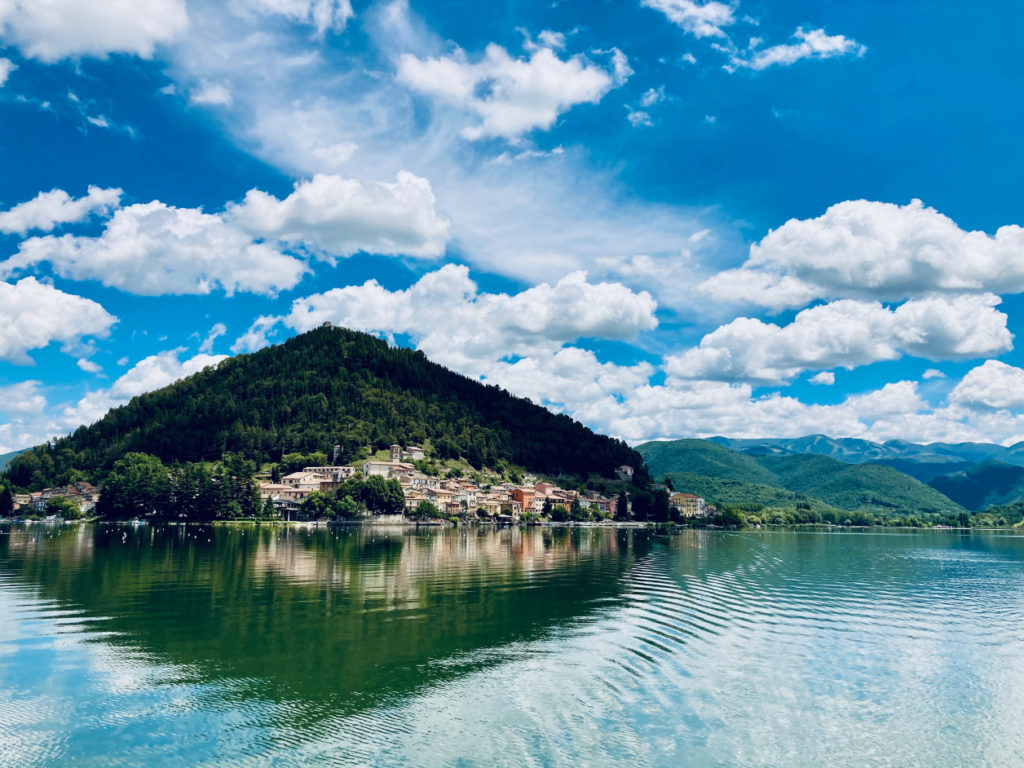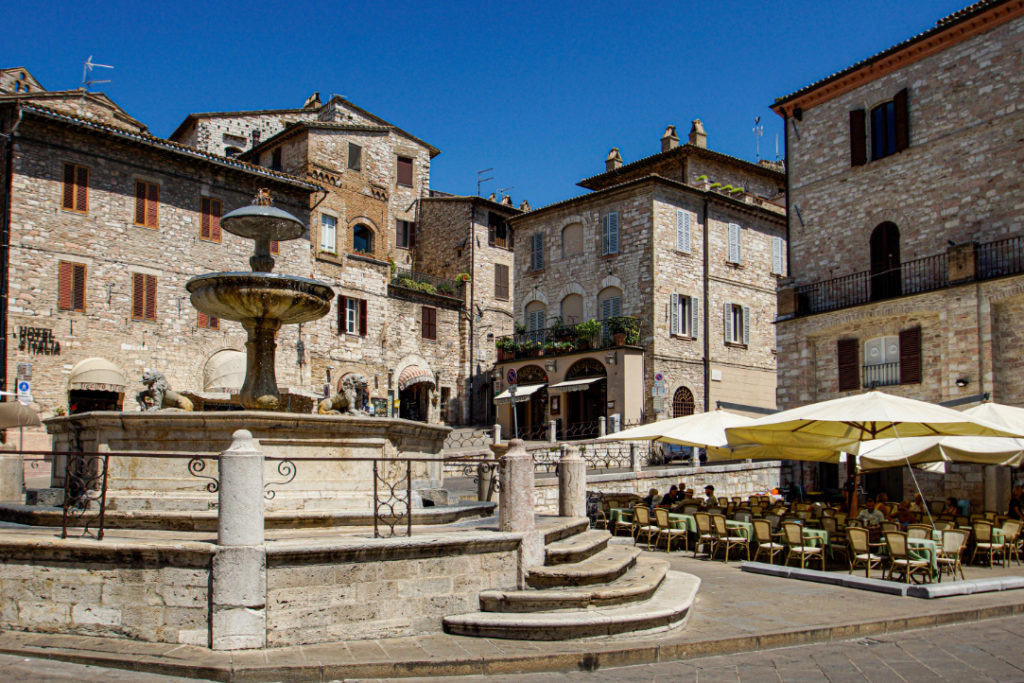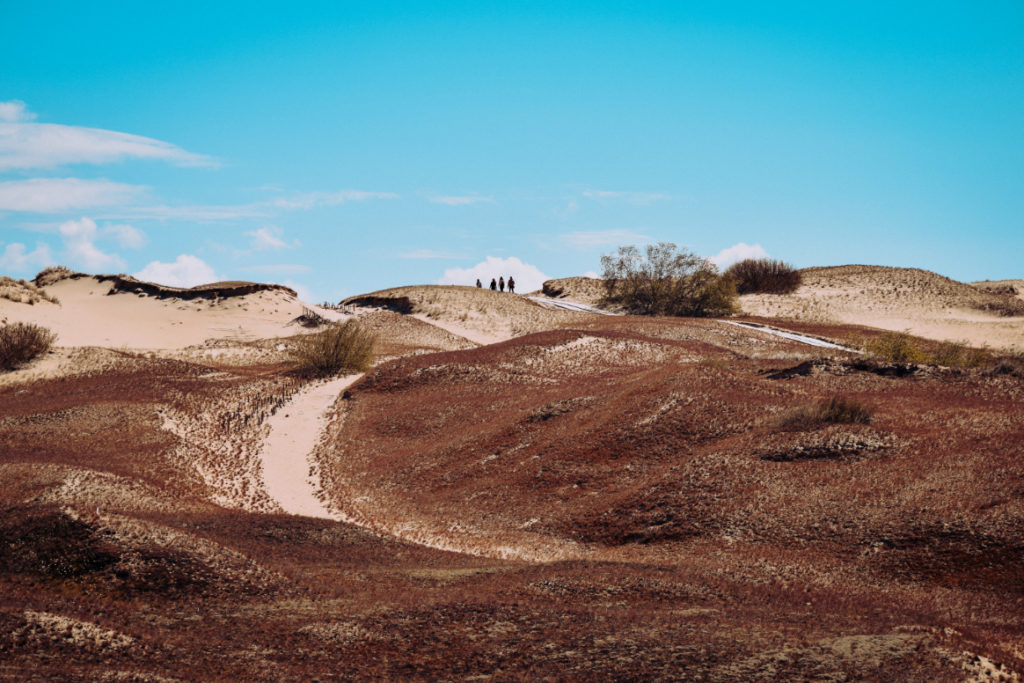Are you planning to explore Europe, or at least parts thereof, on a road trip? Although Europe is a rather small continent, it can be hard to narrow down where exactly you’d like to go. While most places in Europe are worth seeing, not all of them lend themselves easily to road trips. To make matters easier for you, here are three amazing European Road Trip itineraries for you!
This article contains advertising links with our recommendations. With the booking/purchase via one of the links, we receive a commission with which you support our work. Of course, it costs you nothing extra! Thanks for your support!
Umbria
Terni – Narni – Orvieto – Todi – Montefalco – Bevagna – Assisi – Perugia – Lago Trasimeno – Umbertide – Gubbio
Umbria lies at the heart of Italy. The region has no large cities and is often overshadowed by its famous neighbor, Tuscany, making most tourists just skip over it. But don’t underestimate Umbria’s beauty! The landscape is similar to that of Tuscany, with rolling hills, vineyards, and bright pastures. Situated on the hilltops are the charming medieval towns, known for their delicious food and wine. The best time to visit Umbria is during spring when the temperatures are mild and the meadows are blooming.
A drive through Umbria can be a standalone road trip, but since it lies right between Rome and Florence, it can make sense to combine it with both cities! If you’ve already planned a visit to Rome and Florence but chose to travel by train, don’t worry: Orvieto, Terni, Assisi, and Perugia can all be reached by train. This road trip zig-zags through Umbria from Terni to Gubbio, stopping at small villages in between.
What Not to Miss Along the Road Trip
Parco Fluviale del Nera: This nature reserve near Terni is great for outdoor activities. Climb the Ferentillo Rock Face, raft down the river Nera or hike one of the numerous trails, e.g. to Marmore Falls, a gigantic waterfall created by the Romans. Located throughout the park are medieval castles and fortified villages that you can explore, as well.
Assisi: As the birthplace of St. Francis, founder of the Franciscan Order, Assisi is Umbria’s most religiously significant destination. While Assisis‘ historic center, with its charming cobblestone streets, is reason enough to justify a visit, the town’s highlight is the Basilica of St. Francis. The frescoes inside belong to the world’s finest collections of medieval art and have UNESCO World Heritage Status. Besides the basilica, there are many more churches in Assisi that are also worth a visit. However, if you are only there for the day you should spend your time enjoying the ambiance and the view over the countryside.
Lago Trasimeno: Lago Trasimeno is surrounded by quaint towns, of which Castiglione del Lago is the loveliest. Visit its historic center and learn about the town’s rich history, which dates back to the Etruscans. Also during your stay at Lago Trasimeno, be sure to take the ferry to Isla Maggiore, in the middle of the lake. From the island’s bell tower, you’ll have the best view of the area!
Gubbio: The last stop on this trip will be the picturesque town of Gubbio. Already a settlement in pre-Roman times, Gubbio is not only one of the nicest medieval Italian towns, but it is also among the oldest! Remnants of these bronze-age settlers, the Iguvine-Tablets, can be found in the Palazza dei Priori in Gubbio’s city center.
Feeling inspired? Discover more!
Advertising
West Coast of France
Brest – Crozon Peninsula – Quimper – Quiberon – Guérande – Nantes – La Rochelle – Bordeaux – Biscarosse – Arcachon Bay – Biarritz
The Atlantic coast to the west of France is one of three wildly different shorelines the country has to offer. Although it gets a lot less recognition than its Mediterranean counterpart, it is by no means less gorgeous. Some of France’s best beaches can be found at the country’s west coast, along with charming maritime villages and important cultural centers. Due to the rougher waters of the Atlantic Ocean, the lower coast is very well suited for all types of surfing, while the sheltered bays further the north are great for sea-kayaking or stand-up paddling.

Some Highlights of the Road Trip
Crozon Peninsula: The Peninsula across from Brest could easily be worth an entire holiday on its own. Its secluded beaches with stunning turquoise water are comparable to what you’d expect from the Côte d’Azur but without the overflow of tourists. Bike or hike along the many trails to the peninsula’s scenic lookouts, like Cap de la Chèvre, and enjoy the view of the ocean from the top of the cliffs. If you’d rather explore from below, then this is the perfect place to rent a paddleboard or sea kayak!
Arcachon Bay: Arcachon Bay is the perfect year-round destination, because of its mild climate and many hours of sunshine. The bay is protected by the spit of Cap Ferret, causing the water to be calm and great for swimming. All around the bay are small fisherman villages, that are known for their delicious seafood, especially for their oysters. Located a little further down the coast is the Dune du Pilat, Europe’s tallest sand dune! With 107 m (351 ft) in height, it is truly a goliath of dunes. Bring a picnic, climb up the dune and just enjoy the panorama, or, for the more adventurous, try paragliding off of it!
Biarritz: This could be the last stop on the road trip unless you want to extend it into Spain or down to the Mediterranean Coast. What used to be a small fishing village before its „discovery“ by Napoleon’s wife, is now among the most popular beachside resorts in France and one of the foremost surfing locations in all of Europe! The long beaches are broken up by rocky cliffs extending into the ocean, such as the Rocher de la Vierge. Walk across the bridge connecting the rock with the mainland to get a great view of Biarritz, its bays, and the stormy waves crashing into the rock below you.
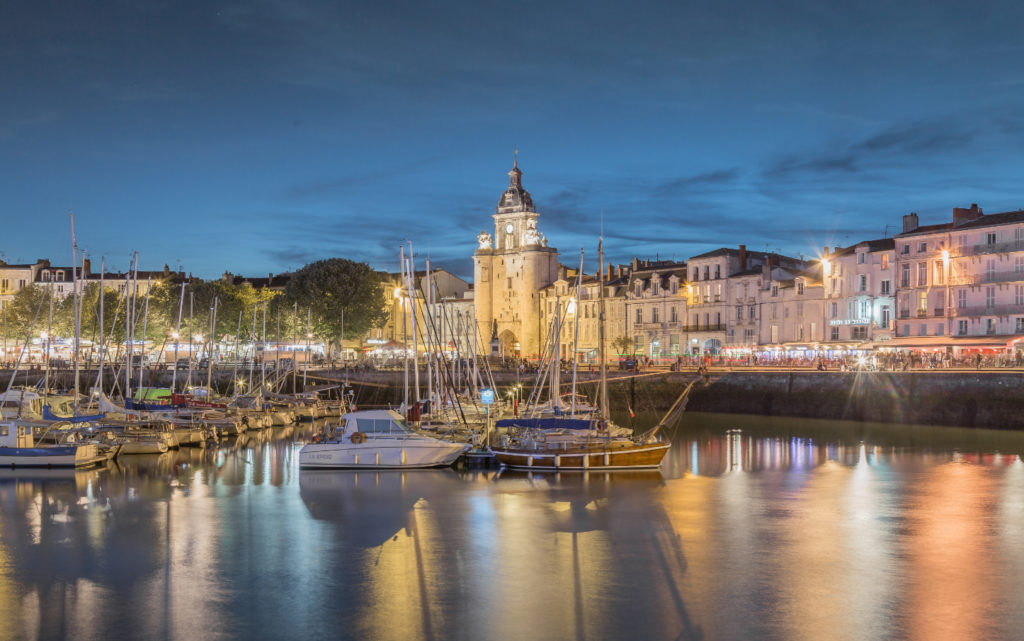
Want to know more? Discover more!
Advertising
The Baltic States
Tallin – Matsalu National Park – Pärnu – Sooma National Park – Sigulda – Riga – Liepāja – Klaipėda – Kaunas – Trakai – Vilnius
Although many more countries border on the Baltic Sea, „The Baltics“ commonly refers to three countries: Lithuania, Estonia, and Latvia. Tucked away in a corner in North-Eastern Europe, they often fall under the radar of tourists, who, if at all, only visit the capital cities as part of a Baltic Sea cruise. To get to know the region, one must go beyond the, albeit very interesting, capitals.
The Baltic States in a Nutshell
Despite them falling into the same geopolitical category, the Baltic Countries all are very different from one another. What they do have in common, are deep forests, lively cities, a rich history, and a beautiful coastline with long sandy beaches.
Estonia: Estonia is the northernmost of the Baltic States. Its capital city is Tallinn, an interesting medieval town whose history as a Hanseatic League Member is still very visible in its city center. Around half of Estonia is covered in forests, and the country is home to many amazing National Parks. The country is also home to over 2000 islands, though only a few are inhabited.
Latvia: Latvia is known for its romantic countryside, with many small lakeside castles and fortresses. Riga, Latvia’s capital, is the largest of the Baltic Capitals and both a party town and cultural center. Riga’s foremost architectural style is Art Nouveau, strongly contrasting the medieval style of Tallinn.
Lithuania: Lithuania is a country packed with culture. Vilnius, the capital of Lithuania, is characterized by a large number of baroque-style buildings and is often called the loveliest of the Baltic capitals. And Kaunas, Lithuania’s second-largest city, was even chosen as the Cultural Capital of Europe 2022! But Lithuania’s countryside should not be overlooked. The lakes in the country’s interior and the extensive dunes along the coast make for a relaxing getaway no matter the time of year.
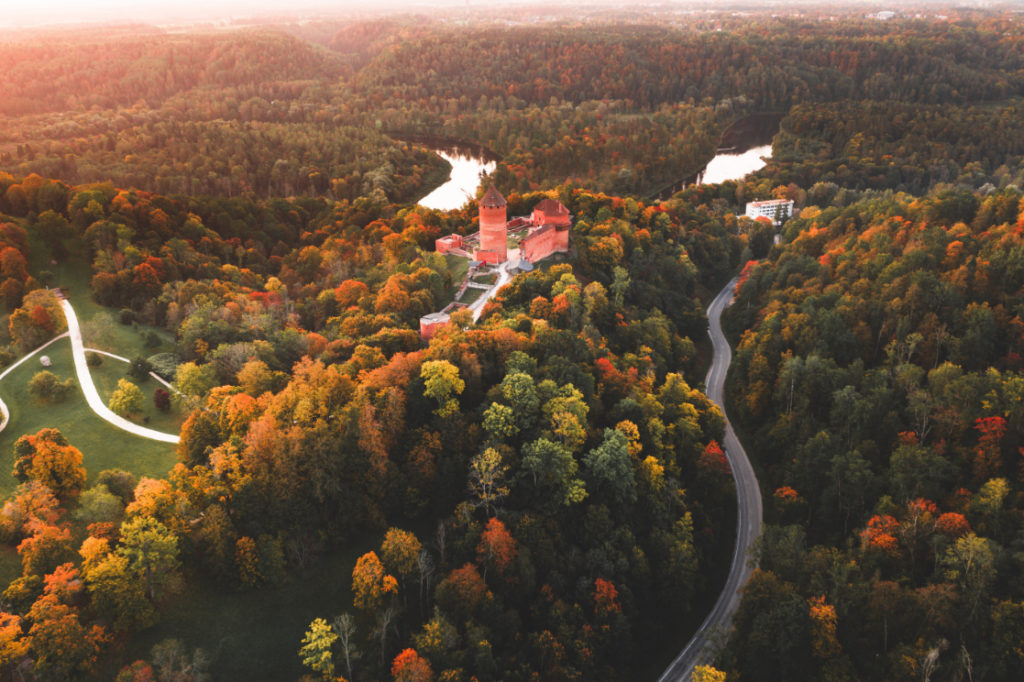
What Not to Miss Along the Road Trip
Sooma National Park: Sooma National Park is a region of boglands in southwestern Estonia. With over 185 bird species, bears, and wolves roaming the forests, Sooma is a paradise for ornithologists and wildlife watching! The reserve’s landscapes can concisely be described by a single word: wet. In the summertime, Sooma can be explored by canoeing down its rivers or on foot, following the winding wooden walkways through the wetlands. Alternatively, you could bring your wellingtons, strap on rented bog shoes, and get right into the mud.
But there are times when Sooma can get too wet, as well. After heavy rainfall or snow melts in the winter, the park experiences strong floods in an event called the fifth season. During this time, when the walkways are inaccessible, the only way to get around Sooma is by boat. In winter, much of the park is frozen over, and pathways and canoes are traded in for snowshoes and kicksleds!
If you can’t make it to Sooma, Matsalu National Park further west or Laheema National Park next to Tallinn are amazing alternatives. To make the best out of your Estonian National park experiences, and to stay safe while exploring, we recommend taking a guided tour of the reserves.
Sigulda: Just an hour’s drive from Riga, amid the woodlands of Gauja National Park, lies the small town of Sigulda. There are two intact castles in Sigulda: the Neo-Gothic New Castle, built in the 19th century, and Turaida Castle, a medieval fortress dating back to the 13th century. The New Castle is worth a short visit, as it is very interesting architecturally. Turaida Castle, however, needs at least a couple of hours to be explored. Climb its tower for a great view of the complex and then visit the surrounding buildings, which house small exhibitions.
Besides the Siguldan fortresses, you should also take some time to see the rest of Gauja National Park. There are various adrenaline-heavy activities here, such as the human catapult in the Tarzan Amusement Park, or the Olympic Bobsledding Track. Gauja is also great for hikes if you’d just like to spend some time in nature. Be sure to see the park from above as well! You can ride in the cable car that travels across the valley, or you could hike (or drive) to Paradise Hill. From Paradise Hill, you get a great view of Turaida Castle peaking out of the treetops. Bring a picnic, because you’ll want to spend some time here!
Curonian Spit: The Curonian Spit is a long and narrow peninsula on the Lithuanian coast. To get there, take a short ferry ride from Klaipėda across. You could stay a few days in a resort on the spit for a beach holiday, or see parts of it on a day trip. While driving and public transport are both options to explore the spit, the best way is to rent a bicycle and ride along the dedicated cycling path from the northern tip down to Nida at the Lithuania-Kaliningrad border. From the many tall dunes on the Curonian Spit, choose to visit the 52 m (170 ft) tall Parnidis Dune by Nida, or the vast Grey Dunes in the Nagliali Nature Reserve. Those interested in ornithology, should also not miss out on the Cormorant and Heron Colony near Juodkrantė.
Bonus
Estonia’s Tallinn lies right across from Finland’s capital Helsinki. A ferry regularly crosses through the Gulf of Finland, connecting them both in under two hours! If you’ve got a few extra days, consider adding Helsinki to your itinerary.
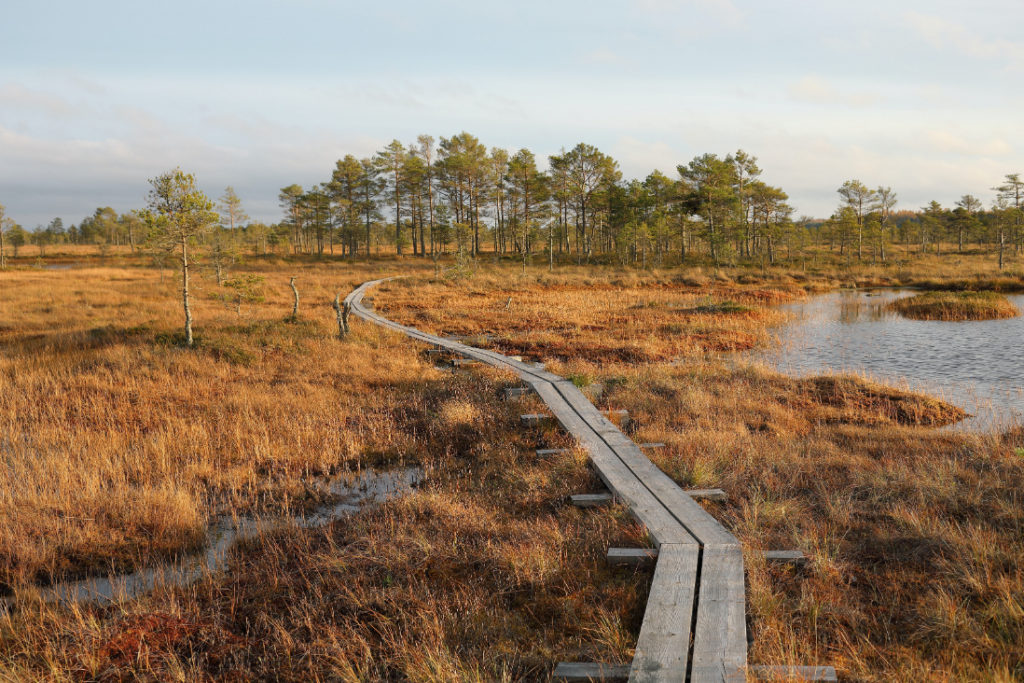
Feeling inspired? Discover more!
Advertising
Follow us on Facebook, Pinterest, and Instagram!
Lambus is an All-In-One travel platform. Your whole trip in your pocket: Waypoints, expenses, tickets, photos, and more!
